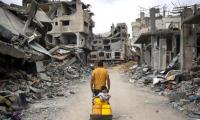Karachi
“In a city which has never really had a sufficient number of public buses for its burgeoning population, it is amusing to see authorities working on a mass transit system that – if and when completed – will be catering to just about 15 percent of the city’s daily commuters. With plans such as these, it will be no surprise to see that people would still be just as dependent on our shambolic public bus system or the more dangerous alternatives such as Qingqis.”
This reality check was presented by Arif Hasan, an architect and urban planner also among the founding members of the Urban Resource Centre, for everyone who attended Thursday’s discussion regarding the Green Line of Bus Rapid Transit held at the NED University’s City Campus.
The talk, which saw many urban planners and architects in attendance, was aimed at informing citizens about the present transport problems faced by the city and whether the BRTS was an answer to these issues.
“Projects have replaced planning and small scale entrepreneurs emerged overtime because of our inadequate public transport system. According to the DIG traffic, half of the city’s bigger buses are not even running on the roads, leaving the people deprived of what remains a basic necessity. Many people, including working women, were forced to resort to small rental vans to fulfill their transport needs. People simply cannot rely on public transport in this city,” said Dr Noman Ahmad, chairperson of the Architecture and Urban Planning Department of the NED University.
“We have seen civic authorities regularly working on broadening the city’s existing roads by pushing back footpaths; going by such efforts, one would be forgiven for believing that all citizens of Karachi can afford at least one vehicle.”
Ahmed added that CNG stations were recently shut down to protest the decision to sell CNG in litres instead of kilograms, adding to the plethora of problems citizens were already facing and reiterating the gravity of the issues with our public transport system.
A viable solution?
However, as on many previous occasions, the question of the BRTS’ viability was raised yet again as people pointed to the multiple development projects that failed to ever see the light of day.
Explaining the project’s dynamics, Sualeh Farooqi, CEO of the Karachi Infrastructure Development Company Limited (KIDCL) which has taken the responsibility of the Green Line, spoke about how the project dates back to 2013 and couldn’t be implemented because of a lack of consensus among government circles.
“There has been a general sense of apathy towards the city’s transport issues but, fortunately, we have at least decided that the existing public transport system has to be upgraded,” he said.
Making way
Catering to a route of about 21.7 kilometres from Surjani Town to Gurumandir, the Green Line would get an investment of Rs16,085.1 million and will have an elevated section of 11.7km and an ‘at-grade’ section of 6.7km.
Speaking about some of the features of Green Line, Farooqi explained that the 25 stations would see daily trips as high as 300,000. There would one depot, two terminals and one corridor along the way. He also mentioned that the work on the project was in full swing and currently 30 percent work on elevated section, GL-01, from Nazimabad Chowrangi to Gurumandir was completed, followed by 25 percent on the section, GL-02, from Nagan Chowrangi to Nazimabad Chowrangi and the construction of Board Office Interchange, GL-03, had reached 30 percent.
However, work on the the water trunk with diameter 1,200mm from Nagan Chowrangi to Sakhi Hasan and relocation of the pumping station near KDA Chowrangi was 85 percent done.
With four elevated stations from Nazimabad Chowrangi to Gurumandir, GL-01, the stations would be on either side of the bus carriageway, with a pedestrian bridge connecting users to the station. The GL-02 seven grade stations would have stations in the centre of the carriage way and would cater to people taking route from Nagan Chowrangi and Nazimabad Chowrangi. The GL-04 elevated stations, numbering 10 would only be on the sides of buses, between Powerhouse and Nagan Chowrangi.
Addressing the concerns of environmentalists, it was assured that the 7,321 trees removed would be replaced by 19,500 new ones. It was added that out of thousands of the trees removed only 800 were relocated because the rest did not provide any benefits.
“The construction was halted for two months to cater to the plantation and the 800 trees will be transplanted to the gardens of Quaid’s Mazaar,” said Komal Pervez, Landscape Architecture Studio’s principal landscape architect. She added there wasn’t any additional cost; rather it was adjusted in the BRTS’ budget.
Shedding light on the architectural aspects, Aqeel Kapadia spoke that unlike the mass transit system in Rawalpindi and Lahore, Green Line stations will have proper ventilation because the buses would not be air-conditioned, and the bridges can be used by pedestrians even when the station is locked down.
It was also told that the system would be an Integrated Intelligent Transporting System (IITS) because of its multipurpose features like automated fare collection, central command and control, security and surveillance, bus docking system among others.
Greener pastures await?
Addressing the reservations of those who felt Green Line would have an impact on the neighbourhoods, a representative of KIDCL assured that the stations were at a safe distance. “There is an elevated section, then there is a service lane, and, lastly, there is a footpath. With a distance of 80 to 90 metres, 8 to 8.5 metres is being used which makes around 10 percent, and in case of stations, 17 metres is used which is around 20 percent.”
When proposed with the idea of using underground systems, Farooqi said that the cost incurred remains same because many times utility lines have to be relocated, and given that the city lacks a proper master plan, it is difficult to find out about old lines.
Roland ‘D Souza, an engineer and a green activist, said that like previous projects, the BRTS should not become a bone of contention among those who control the city. “This fight is going to be so bad that the rights of the citizen will be thrown out of the window.”
When posed with a question about whether the citizens were ready to use such services, Farooqi said the people deserved better. “When they would realise that their money is invested in the infrastructure, they would own it instead of destroying it. Also, a city is like a living organism which grows, so issues will occur and they would have to be dealt with accordingly.”
Given that Numaish Chowrangi is known for protests and processions, a student asked if there would be adverse effects because all lines crossed through that particular junction.
Farooqi explained that they were still in discussions about the option of an underground section because, unlike other places, a lot of area was available here. However, he agreed when it was pointed out that that BRT may suffer because of persistent power outages because the system relied on electricity and would seek K-Electric’s supply and an alternative power source to run.
Concluding the session, Arif Hasan, remarked that although the transport system of the city was better earlier, the nostalgia was often misplaced because it was dominated by elitism that did not let populism thrive.
As someone who opposes elevated structures, he said that he was thankful that the BRTS was brought down to Merewether Tower: “The consequences after BRTS’ construction are to be taken seriously.
Firstly, we need monitored institutions which would train people who would look after the project because the system just cannot work without them.
Secondly, the disruptions need to be addressed, because lowering the transit would lead to a divide between the two sides of MA Jinnah roads — the wholesalers at one end and retailers at the other have a significant relationship.”
Mazar-e-Quaid can be seen in this image in Karachi. — AFP/File PatternsThe Canvas Gallery is hosting an art...
Representational image showing a person cycle on the road. — Unsplash KARACHI: Allied Bank Limited , a leading...
Mirza Ikhtiar Baig presents the 16th Corporate Social Responsibility Award 2024 at an event organised by the...
This image released on March 13, 2024, shows Sindh Local Government Minister Saeed Ghani. — Facebook/Saeed GhaniThe...
The Sindh High Court building in Karachi. — SHC website.The Sindh High Court has dismissed high court appeals filed...
A blackout in Pakistan plunged much of the country, including its economic hub Karachi, into darkness, January 10,...







